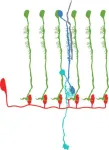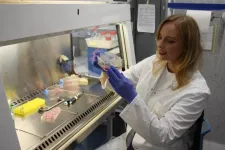(Press-News.org) Researchers at the University of Arizona’s Mel and Enid Zuckerman College of Public Health received a $1.75 million Centers for Disease Control and Prevention grant to conduct a community-based, participatory research study designed to improve vaccine uptake in Arizona’s rural and border communities.
Vaccination is a highly effective public health intervention that saves millions of lives per year, yet vaccination rates have declined in recent years for a variety of reasons, ranging from safety concerns to religious and philosophical objections.
“Vaccination is a cornerstone of public health,” said co-principal investigator Tomas Nuño, PhD, an assistant research professor in the Department of Epidemiology and Biostatistics. “We need to build trust and connection so that our community partners see the benefits of vaccination across the lifespan. They also need to be able to evaluate all the misinformation about vaccines that is so common now.”
The five-year study, titled “Community-Based Participatory Research to Enhance Vaccine Uptake Across the Lifespan through Innovative Points of Access and Altering Norms in Border and Rural Regions,” will integrate socioecological and health beliefs model framing to understand the roles of socioeconomic factors, trust in health systems and public health authorities, and perceptions of vaccine efficacy and risk.
Following the COVID-19 pandemic, the Chiricahua Community Health Centers Inc. in rural southeast Arizona initiated an innovative project to enhance vaccination by placing an immunization specialist in dental clinics affiliated with the federally qualified health center system. This approach has shown promising results.
Nuño will lead a research team that seeks to build on the success of CCHCI’s community-based dental clinic immunization program. The team will expand the CCHCI program and initiate a partnership with the Mariposa Community Health Center in Santa Cruz County to increase vaccine uptake among adults, adolescents, families and communities.
Researchers will also develop, pilot and assess a multilevel intervention strategy aimed at improving vaccination rates within populations that face barriers to health care access. They will focus on people residing in rural and hard-to-reach areas or individuals who do not typically utilize Federally Qualified Health Centers.
Nuño, assistant research professor in epidemiology and biostatistics and engagement core faculty lead for the University of Arizona-Banner Health All of Us Research Program, will lead this project with co-principal investigator Kate Ellingson, PhD, an associate professor in epidemiology and biostatistics, and co-investigator Sheila Soto, DrPH, MPH, an assistant research professor and director of engagement and outreach programs.
“The recent decline in vaccination rates following the COVID pandemic is a top concern for public health,” said Iman Hakim, MD, PhD, MPH, dean of the Zuckerman College of Public Health. “I’m so pleased that Dr. Nuño and his team have received this CDC funding to develop innovative ways to engage our underserved communities and restore trust in vaccines.”
In addition to Nuño, Ellingson and Soto, the research team includes Scott Carvajal, PhD, MPH, professor and chair of the Health Promotion Sciences Department and co-director of the Arizona Prevention Resource Center, and Federally Qualified Health Center partners Emily Harris, MPH, infectious disease program manager for the Chiricahua Community Health Centers Inc., and Patty Molina, MPH, senior director of community health services at the Mariposa Community Health Center.
END
$1.75M CDC grant funds study to boost vaccine acceptance in Arizona’s rural, border communities
Epidemiologist Tomas Nuño, PhD, is leading a study designed to improve vaccination rates and create new strategies to break down barriers to vaccination in populations with limited access to health care.
2024-10-31
ELSE PRESS RELEASES FROM THIS DATE:
Immune system review provides insight into more effective biotechnology
2024-10-31
Macrophage cells are the immune system’s frontline soldiers, early on the scene to protect the body from foreign invaders. These cells answer the immune system's critical question for the rest of its troops: friend or foe?
As critical responders, macrophages can perceive helpful biotechnology as threats. If not created with the right materials or mechanical forces, these devices can trigger an immune response that can cause inflammation, scar tissue or device failure.
But what is the right material or the right mechanical force? In a meta-analysis co-led ...
Remote control eddies: Upwelled nutrients boost productivity around Hawaiian Islands
2024-10-31
Beyond colorful coral reefs and diverse nearshore ecosystems, Pacific Ocean waters surrounding the Hawaiian Islands have comparatively little marine life and low biological productivity. New research published by University of Hawai‘i (UH) at Mānoa oceanographers showed that eddies on the leeward side of the Hawaiian Islands can supply nutrients, not only locally, but also to the opposite side of the island chain and stimulate blooms of phytoplankton, microscopic plant life that lives in the surface ocean.
The study, published in JGR Oceans, was selected by the American Geophysical Union’s editorial board as a featured article.
“While ...
Rice, Texas Medical Center institutions jointly award seed grants
2024-10-31
Rice University together with Baylor College of Medicine and the Houston Methodist Academic Institute has awarded seed grants in support of research on health equity and digital health.
Spearheaded by Rice’s Educational and Research Initiatives for Collaborative Health (ENRICH) office in collaboration with the two partnering institutions in the Texas Medical Center (TMC), the seed grant opportunity followed the Health Equity Workshop hosted earlier this year by Rice’s Digital Health Initiative.
“To achieve equitable health outcomes, a comprehensive approach is essential — one ...
Sleeping for 2: Insomnia therapy reduces postpartum depression, study shows
2024-10-31
While many people believe that poor sleep during pregnancy is inevitable, new research has determined that cognitive behavioral therapy for insomnia (CBTi) while pregnant can not only improve sleep patterns but also address postpartum depression.
Researchers from UBC’s Okanagan and Vancouver campuses, as well as the University of Calgary, discovered that delivering CBTi during pregnancy significantly reduces postpartum depressive symptoms after a baby arrives.
“Early intervention is crucial for infant and parental mental health,” says Dr. Elizabeth Keys, an Assistant Professor in UBCO’s School of Nursing and a study co-author. “Our research explores how addressing ...
How fruit flies achieve accurate visual behavior despite changing light conditions
2024-10-31
When light conditions rapidly change, our eyes have to respond to this change in fractions of a second to maintain stable visual processing. This is necessary when, for example, we drive through a forest and thus move through alternating stretches of shadows and clear sunlight. "In situations like these, it is not enough for the photoreceptors to adapt, but an additional corrective mechanism is required," said Professor Marion Silies of Johannes Gutenberg University Mainz (JGU). "Earlier work undertaken by her research group had already demonstrated that such a corrective 'gain control' mechanism exists ...
First blueprint of the human spliceosome revealed
2024-10-31
Researchers at the Centre for Genomic Regulation (CRG) in Barcelona have created the first blueprint of the human spliceosome, the most complex and intricate molecular machine inside every cell. The scientific feat, which took more than a decade to complete, is published today in the journal Science.
The spliceosome edits genetic messages transcribed from DNA, allowing cells to create different versions of a protein from a single gene. The vast majority of human genes – more than nine in ten – are edited by the spliceosome. Errors in the process are linked to a wide spectrum of diseases including most types of cancer, neurodegenerative conditions and genetic ...
The harmful frequency and reach of unhealthy foods on social media
2024-10-31
An analysis of social media posts that mention food and beverage products finds that fast food restaurants and sugar sweetened beverages are the most common, with millions of posts reaching billions of users over the course of a year. The study, published in the open access journal PLOS Digital Health, highlights the sheer volume of content normalising unhealthy eating, and argues that policies are needed to protect young people in the digital food environment.
Obesity is a health challenge around the world and food environments, including in the digital space, can influence ...
Autistic traits shape how we explore
2024-10-31
People with stronger autistic trails showed distinct exploration patterns and higher levels of persistence in a computer game, ultimately resulting in better performance than people with lower scores of autistic traits, according to a new study published this week in PLOS Computational Biology by Francesco Poli of Radboud Universiteit, the Netherlands, and colleagues.
Scientists know that individuals display curiosity and explore their environments to learn. How a person selects what they want to explore plays a pivotal role in how they learn and research has shown that exploration levels are highly variable across ...
UCLA chemists just broke a 100-year-old rule and say it’s time to rewrite the textbooks
2024-10-31
Key takeaways
According to Bredt's rule, double bonds cannot exist at certain positions on organic molecules if the molecule's geometry deviates too far from what we learn in textbooks.
This rule has constrained chemists for a century.
A new paper in Science shows how to make molecules that violate Bredt’s rule, allowing chemists to find practical ways to make and use them in reactions.
UCLA chemists have found a big problem with a fundamental rule of organic chemistry that has been around for 100 years — it’s ...
Uncovered: the molecular basis of colorful parrot plumage
2024-10-31
A single enzyme fine-tunes red and yellow pigments in parrots’ polychromatic plumage, according to a new study. The findings reveal new insights into the molecular mechanisms underlying the evolution and display of color variation in one of nature’s most colorful birds. Colors play a central role in ecological adaptation and communication in the natural world. This is particularly true for birds, which are especially notable among animals for their wide range of vibrant plumage colors and patterns. Among birds, ...
LAST 30 PRESS RELEASES:
Post-stroke injection protects the brain in preclinical study
Cardiovascular risk score predicts multiple eye diseases
Health: estimated one in ten British adults used or interested in GLP-1 medications for weight loss
Exercise to treat depression yields similar results to therapy
Whooping cough vaccination for pregnant women strengthens babies’ immune system
Dramatic decline in new cases of orphanhood in Uganda driven by HIV treatment and prevention programs
Stopping weight loss drugs linked to weight regain and reversal of heart health markers
Higher intake of food preservatives linked to increased cancer risk
Mass General Brigham–developed cholera vaccine completes phase 1 trial
First experimental validation of a “150-year-old chemical common sense” direct visualization of the molecular structural changes in the ultrafast anthracene [4+4] photocycloaddition reaction
Lack of support for people on weight loss drugs leaves them vulnerable to nutritional deficiencies, say experts
Dogs’ dinners can have greater climate impact than owners’
Are you ready to swap salmon for sprats and sardines?
1.6 million UK adults used weight loss drugs in past year
American College of Cardiology comments on new dietary guidelines for Americans
American Society of Gene & Cell Therapy and Orphan Therapeutics Accelerator partner to advance and commercialize promising rare disease treatments
One in 14 patients having day case surgery have new or worse chronic pain 3 months after their operation
New study highlights link between eviction rates and gun violence
Heatwaves heat up soil but not toxin levels in rice, study finds
Digital modeling reveals where construction carbon emissions really come from
Turning farm waste into water filters
New study shows how the spleen helps the immune system accept a transplant
New Mayo Clinic study advances personalized prostate cancer education with an EHR-integrated AI agent
Researchers identify novel therapeutic target to improve recovery after nerve injury
Microbes in breast milk help populate infant gut microbiomes
Reprogramming immunity to rewrite the story of Type 1 diabetes
New tool narrows the search for ideal material structures
Artificial saliva containing sugarcane protein helps protect the teeth of patients with head and neck cancer
Understanding the role of linear ubiquitination in T-tubule biogenesis
Researchers identify urban atmosphere as primary reservoir of microplastics
[Press-News.org] $1.75M CDC grant funds study to boost vaccine acceptance in Arizona’s rural, border communitiesEpidemiologist Tomas Nuño, PhD, is leading a study designed to improve vaccination rates and create new strategies to break down barriers to vaccination in populations with limited access to health care.






